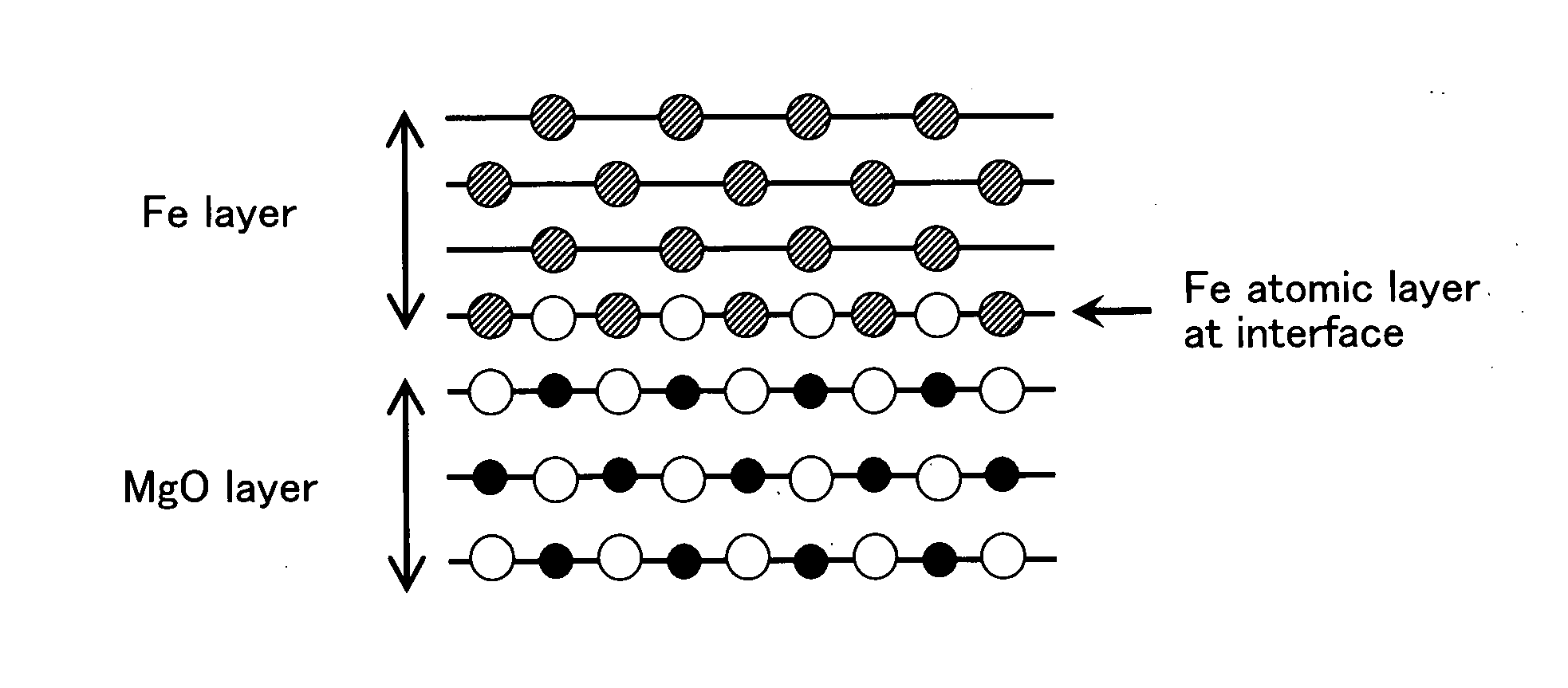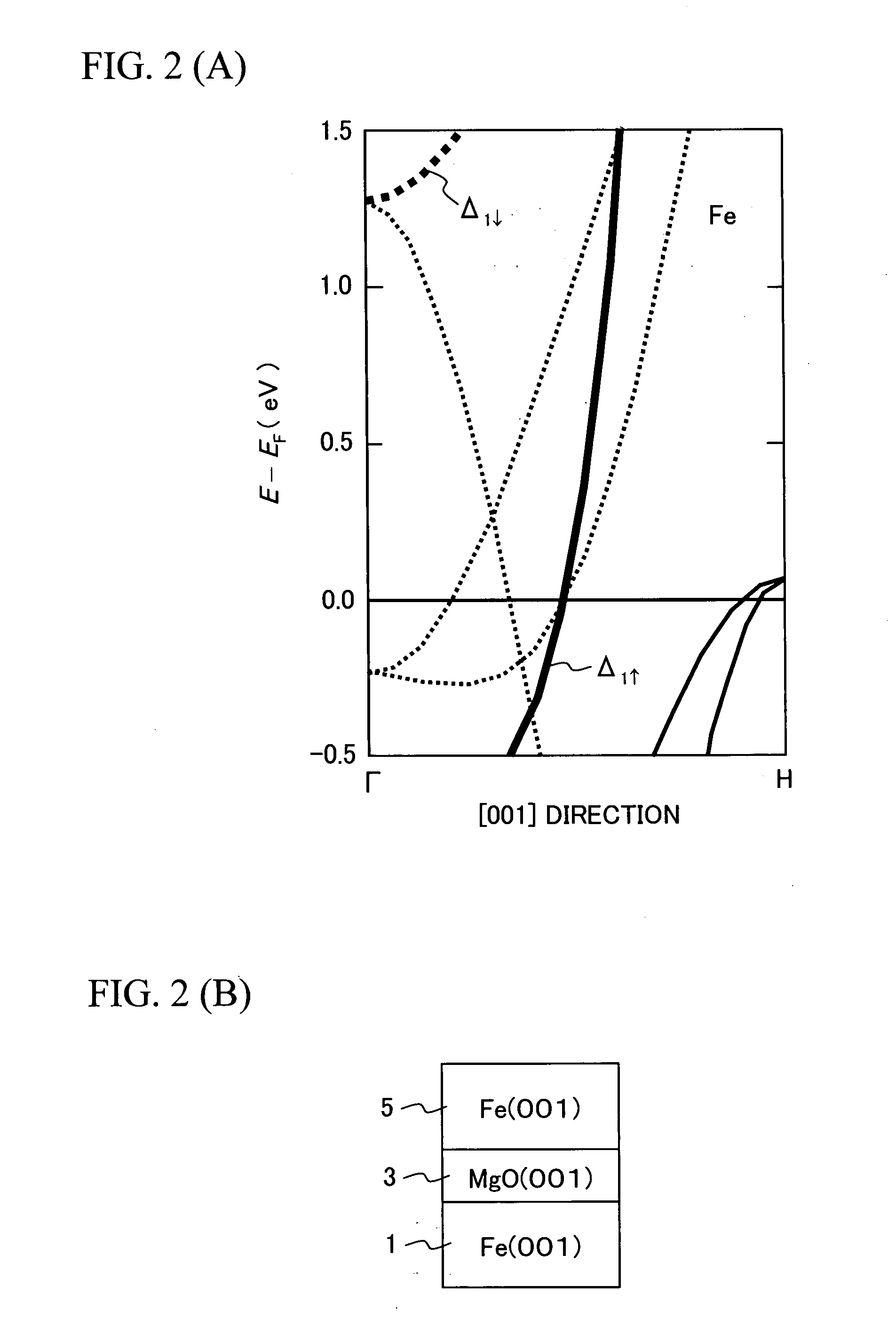Magnetic Tunnel Junction Device and Method of Manufacturing the Same
a tunnel junction and magnetic tunnel technology, applied in the field of magnetic tunnel junction devices, can solve the problems of signal loss in noise, inability to read signals, and too small output voltage when operating margins are considered for devices to be employed for actual memory devices, etc., and achieve the effect of enhancing the tunneling probabilities of carriers
- Summary
- Abstract
- Description
- Claims
- Application Information
AI Technical Summary
Benefits of technology
Problems solved by technology
Method used
Image
Examples
first embodiment
[0059] In the following, a MTJ device according to the invention and a method of manufacturing the same will be described with reference to the drawings. FIGS. 3(A) to 3(D) schematically show the method of manufacturing the MTJ device having the Fe (001) / MgO (001) / Fe(001) structure according to the embodiment (to be hereafter referred to as a “Fe(001) / MgO (001) / Fe(001) MTJ device”). Fe refers to a ferromagnetic material with the BCC structure. First, a single-crystalline MgO (001) substrate 11 is prepared. In order to improve the morphology of the surface of the single-crystalline MgO (001) substrate 11, a MgO (001) seed layer 15 is grown by the molecular beam epitaxy (MBE) method, for example. This is subsequently followed by the growth of an epitaxial Fe(001) lower electrode (first electrode) 17 with a thickness of 100 nm on the MgO (001) seed layer 15 at room temperature, as shown in FIG. 1(B). Annealing is then performed at 350° C. under ultrahigh vacuum (2×10−8 Pa), whereby the...
second embodiment
[0086] Hereafter, a magnetic tunnel junction device according to the invention and a method of manufacturing the same will be described. In the method of manufacturing a MTJ device according to the present embodiment, MgO (001) is initially deposited in a poly-crystalline or amorphous state by sputtering or the like, and then an annealing process is performed such that a polycrystal in which the (001) crystal plane is oriented or a single crystal is obtained. The sputtering conditions were such that, for example, the temperature was room temperature (293K), a 2-inch φ MgO was used as a target, and sputtering was conducted in an Ar atmosphere. The acceleration power was 200 W and the growth rate was 0.008 nm / s. Because MgO deposited under these conditions is in an amorphous state, a crystallized MgO can be obtained by increasing the annealing temperature to 300° C. from room temperature and maintaining that temperature for a certain duration of time.
[0087] An oxygen deficiency may be...
PUM
| Property | Measurement | Unit |
|---|---|---|
| thickness | aaaaa | aaaaa |
| thickness | aaaaa | aaaaa |
| thickness | aaaaa | aaaaa |
Abstract
Description
Claims
Application Information
 Login to View More
Login to View More - R&D
- Intellectual Property
- Life Sciences
- Materials
- Tech Scout
- Unparalleled Data Quality
- Higher Quality Content
- 60% Fewer Hallucinations
Browse by: Latest US Patents, China's latest patents, Technical Efficacy Thesaurus, Application Domain, Technology Topic, Popular Technical Reports.
© 2025 PatSnap. All rights reserved.Legal|Privacy policy|Modern Slavery Act Transparency Statement|Sitemap|About US| Contact US: help@patsnap.com



